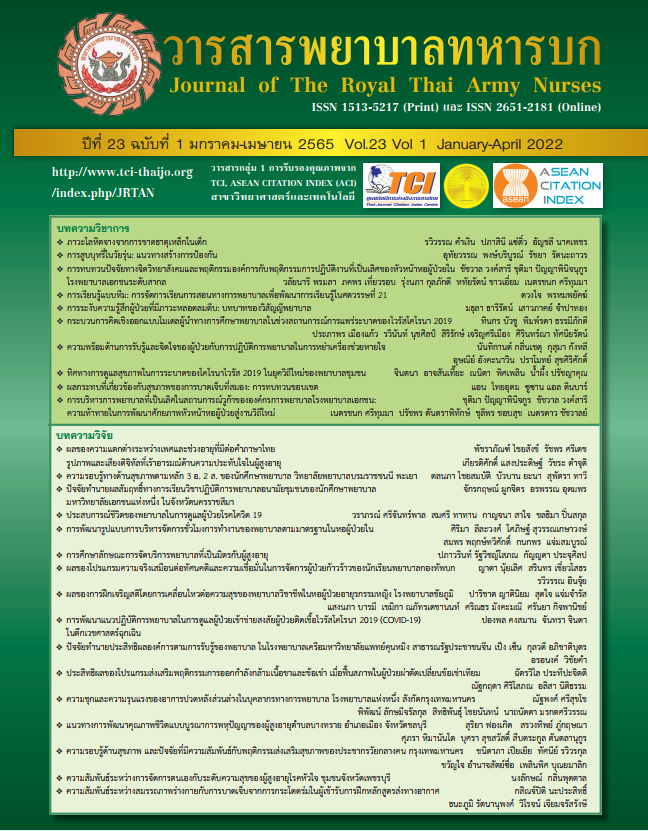The Predictors of Organizational Effectiveness as Perceived by Nurses in Affiliated Hospitals of Kunming Medical University, the People’s Republic of China
Keywords:
Organizational effectiveness, Organizational culture, Transformational leadership, NurseAbstract
This predictive research aims to examine the predictors of organizational effectiveness as perceived by nurses in affiliated hospitals of Kunming Medical University, the People’s Republic of China. The participants included 410 nurses. The research instruments were composed of the Leadership Practices Inventory, the Organizational Culture Profile, and the Organizational Effectiveness Questionnaire. The Cronbach’s alpha coefficients of these instruments were .97, .96, and .94, respectively. Data were analyzed using descriptive statistics and binary logistic regression analysis.
The results revealed that nurses perceived organizational effectiveness at a moderate level. Transformational leadership (OR = 1.82, 95% CI = 1.22-2.73), and three components of organizational culture including performance orientation (OR = 4.09, 95% CI = 1.81-9.22), innovation (OR = 2.10, 95% CI = 1.06-4.15), and stability (OR = 2.23, 95% CI = 1.23-4.04) could explain 39.00% of variability in organizational effectiveness (Nagelkerke R2 = .39). The results of this study provide basic information for improving organizational effectiveness by developing head nurse’s transformational leadership and organizational culture.
Downloads
References
Sun J, Guo Y, Wang X, Zeng Q. Health for aging China: Opportunities and challenges. Aging Dis. 2016;7(1): 53-67.
Li X, Krumholz HM, Yip W, Cheng KK, De Maeseneer J, Meng Q,... Zhang Q. Quality of primary health care in China: Challenges and recommendations. Lancet. 2020; 395(June): 1802-1812.
Mott PE. The characteristics of effective organizations. New York: Harper and Row; 1972.
Lin YW, Lin YY. Health-promoting organization and organizational effectiveness of health promotion in hospitals: A national cross-sectional survey in Taiwan. Health Promot Int. 2011; 26(3):362-375.
Trierweiller AC, Peixe BCS, Tezza R, Do Valle Pereira VLD, Pacheco W, Bornia AC, De Andrade DF. Measuring organizational effectiveness in information and communication technology companies using item response theory. Work. 2012; 41(Supplement 1):2795-2802.
Hser N. Head nurse leadership style and organizational effectiveness of general hospitals in Yangon, the Union of Myanmar [Thesis]. Chiang Mai, Thailand: Chiang Mai University; 2010.
Kraisree N. Transformational leadership, organizational culture and organizational effectiveness as perceived by professional nurses in community hospitals, northern Region [Thesis]. Chiang Mai, Thailand: Chiang Mai University;2013. (inThai)
O’Reilly CA, Chatman J, Caldwell DF. People and organizational culture: A profile comparison approach to assessing person-organization fit. Acad Manage J. 1991; 34(3): 487-516.
Prenkert F, Ehnfors M. A measure of organizational effectiveness in nursing management in relation to transactional and transformational leadership: A study in a Swedish county hospital. J Nurs Manag. 1997; 5(5): 279-287.
Wang XL. Communication satisfaction and organizational effectiveness as perceived by Nurses in University Hospitals, Kunming, the People’s Republic of China [Thesis]. Chiang Mai, Thailand: Chiang Mai University; 2013.
The First Affiliated Hospital of Kunming Medical University. Nursing administration policy. Kunming: Department of Nursing, the First Affiliated Hospital of KMU; 2019. (in Chinese)
Kouzes JM, Posner BZ. The leadership challenge. San Francisco: Jossey-Bass; 2002.
Yamane T. Statistics: An introductory analysis. Tokyo: Harper international;1973.
Chen HC, Baron M. Psychometric properties of the Chinese leadership practices inventory. Int J Nurs Educ Scholarsh. 2007;4(1): 23-37.
Sarros JC, Gray J, Densten I, Cooper BK. The organizational culture profile revisited and revised: An Australian perspective. Aust J Manag. 2005; 30(1):127-143.
Yao L. Organizational culture and quality of work life among nurses in Tertiary Hospitals, Yunnan Province, the People’s Republic of China [Thesis]. Chiang Mai, Thailand: Chiang Mai University; 2013.
Cha ES, Kim KH, Erlen JA. Translation of scales in cross-cultural research: Issues and techniques. J Adv Nur. 2007; 58(4):386-395.
Zhou M, Zhao L, Kong N, Campy KS, Qu S. What caused seriously shortage of Chinese nurses?. Iran J Public Health. 2018; 47(7):1065-1067.
Kane R, Shamliyan T, Mueller C, Duval S, Wilt T. The association of registered nurse staffing levels and patient outcomes: A systematic review and meta-analysis. Med Care. 2007; 45(12):1195-1204.
Li Y. Emotional intelligence and transformational leadership of head nurses in University hospitals of Kunming medical University, the people’s republic of China [Thesis]. Chiang Mai, Thailand: Chiang Mai University; 2011.
Watcharakate S. Transformational Leadership: The Challenging of the Nurse Leaders Transformational Leadership: The Challenging of the Nurse Leaders. Journal of The Royal Thai Army Nurses. 2014; 15(3): 58-63. (in Thai)
Downloads
Published
How to Cite
Issue
Section
License
Copyright (c) 2022 Journal of The Royal Thai Army Nurses

This work is licensed under a Creative Commons Attribution-NonCommercial 4.0 International License.
บทความหรือข้อคิดเห็นใดใดที่ปรากฏในวารสารพยาบาลทหารบกเป็นวรรณกรรมของผู้เขียน ซึ่งบรรณาธิการหรือสมาคมพยาบาลทหารบก ไม่จำเป็นต้องเห็นด้วย
บทความที่ได้รับการตีพิมพ์เป็นลิขสิทธิ์ของวารสารพยาบาลทหารบก
The ideas and opinions expressed in the Journal of The Royal Thai Army Nurses are those of the authors and not necessarily those
of the editor or Royal Thai Army Nurses Association.






